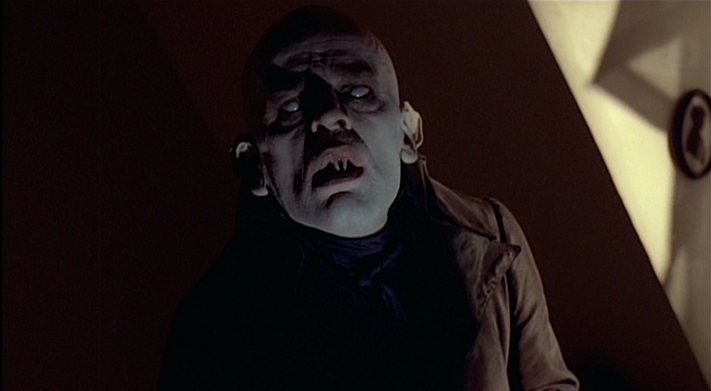
auteur horror:
NOSFERATU
christopher funderburg
This annual October series considers the consequences of when international auteurs reknowned for excellence in the field of le cinema dip their toes in the chilly waters of the disreputable horror genre; an exploration of what happens when Claire Denis or Jim Jarmusch takes on vampirism, Nicholas Roeg dreams about killer dwarves, Philip Kaufman gets paranoid about pod people, Ingmar Bergman howls at the moon or Michael Powell indulges his voyeurism fetish. A series about the beautiful collision of grindhouse and art-house.
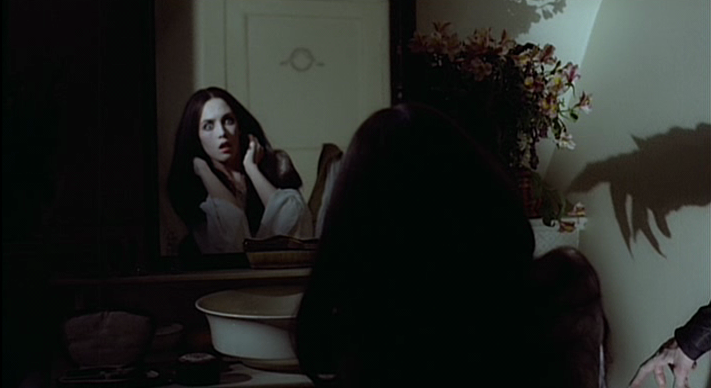
NOSFERATU: PHANTOM DER NACHT
werner herzog, 1979
For this Halloween-y project on directors not usually associated with the horror genre taking a stab at it,* noted cinematic visionary turned embarrassing shtick-peddler Werner Herzog represents an especially interesting case study: apart from Nosferatu: Phantom der Nacht, not only did Herzog never make another film that indisputably belonged to the horror genre, he almost never made any film that could be easily located within any genre. Obviously, it's hard to apply any kind of label to something like Even Dwarfs Started Small, a series of nightmarish comedic vignettes starring a cast composed entirely of midgets centered around the basic concept of... what? The film is frequently described as being about a group of mental patients who take over their asylum, but it's not that specific: it's a group of supplicants who run wild in an institutional setting, but their actions are inscrutable not rebellious. Scenes include an endless sequence of chickens being thrown through a tiny window and our hero Hombre haplessly & endlessly attempting to stack enough magazines on top of each other so that he can climb up the pile to get into bed.
Is this a melodrama? A youth-in-revolt film a'la Zero for Conduct, Blackboard Jungle or If... sans the seemingly crucial "youth" element? Feel free to contort yourself to link it to countercultural dramadies like One Flew Over the Cuckoo's Nest or King of Hearts - you'll find those comparisons lacking. None of Herzog's greatest films fit comfortably under standard genre labels like "war film," "romantic comedy," "police procedural," or even "art film." Stroszek is unlike anything else. Aguirre, the Wrath of God is unlike anything else. Fitzcarraldo, the story of a man attempting to pull a steamship over a mountain deep in the Brazilian jungle as part of a plan to build an Opera house therein, might be his most recognizably subgeneric film with its glancing resemblance to "dreamer pursues his impossible dreams against all odds" films like October Sky, Tucker and Windshield Wiperman Fights A Car Company. But how willing are you to say that Fitzcarraldo is pressed from the same template as the one applied to the story of Greg Kinnear's quest to win a lawsuit over stolen windshield-wiper patent designs? Even Herzog's documentaries are baldly truth-bending spectacles locked in a battle between ecstatic truth and verifiable reality - his work doesn't even fit into that broadest of broad categories like "documentary" and "narrative." So what happens when the filmmaking embodiment of sui generis goes genre?
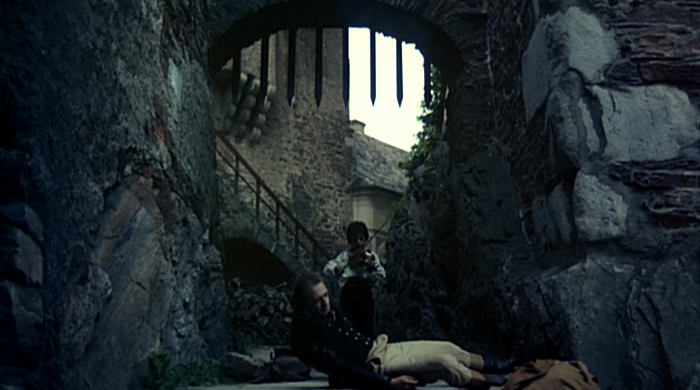
In light of all this Herzogian untameability, Nosferatu's fidelity to the basic story found in Bram Stoker's epistolary novel Dracula might be especially surprising; Herzog even manages to include scenes of letter/diary-writing, a suprisingly cinematically dull nod to the source material. It's all there, more or less as you remember it: Jonathan Harker's journey to the Transylvanian Count's forbidding castle, demented Renfield, luscious Lucy, unconsecrated soil hidden in coffins, Mina, stakes, mirrors and crosses. Herzog has not only undeniably made a horror film, but the horror film, the definitive vampire tale that set a template that endures to this day.
As far as story is concerned, there are no deviations - interestingly, Nosferatu might be the clearest example of something proved in inverse in his other work: Herzog's ecstatic truth isn't derived from plot at all, but from something else entirely, something more mysterious and spiritual and aesthetic. His approach to Stoker's tale allows him to create the greatest Dracula film of all, but one which I can totally understand getting left off of "Best Vampire Movie" lists (which it regularly does.) As closely as Herzog follows the well-worn Dracula template, his style, his artistic gestures, reject the standard telling altogether.
But let's back up. In light of his search for "previously unimagined cinematic landscapes," it's easy to lose sight of Herzog's deep respect for cinema history. Like so many of his subjects, Herzog is an impassioned acolyte; his likely apocryphal autobiography has him receiving the holy host when seeing a film (his first!) at age 18, being reborn, stealing a camera and never looking back on his pilgrimage to become a filmmaker. Part of Herzog's artistic identity is exploration, both literal and figurative: new forms of expressions forged in footage shot in Amazonian wilds, Antarctic underseas and detritus-riddled deserts. He doesn't generally vampirize cinema's past with self-conscious references, winks and nods; he's not from the school of dropping homages in his character names, stories, costumes and production design - in that sense, it's highly appropriate that Nosferatu is the only instance I can think of where he explicitly references cinema's past. His Count Dracula, played by Klaus Kinski, is made up to look almost identical to Max Shrek's iconic take on the role in F.W. Murnau's classic version of the story. That Herzog has called his film Nosferatu and not Dracula hammers home the connection. Nosferatu might be the only instance where Herzog wants you to explicitly recall other films - hell, even his sequel/remake Bad Lieutenant: Port of Call New Orleans aggressively struggles to deny the existence of Abel Ferrara's original and erase it from memory.
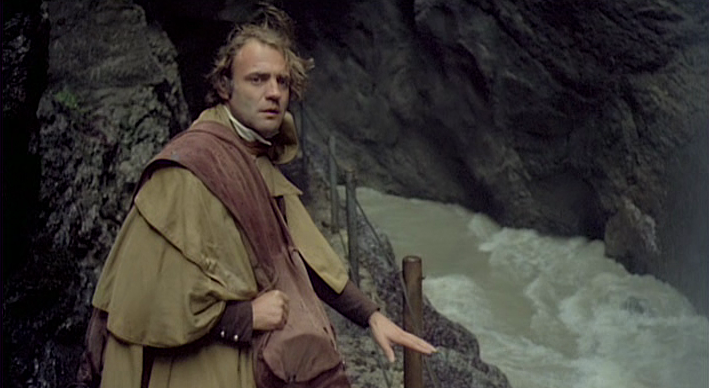
But a lack of winking references aside, Herzog has always evinced a strong connection to film history, particularly German/Austrian cinema history. He famously walked from Munich to Paris with two film canisters in a self-described pilgrimage to visit the ailing critic Lotte Eisner in the hospital - Eisner is most renowned for her comprehensive work on Murnau as well as Fritz Lang and her exploration of pre-War German cinema in general.
In addition to Kinski's creature effects design, Herzog's Nosferatu frequently uses shadows to evoke the Expressionist cinema in which Eisner specialized - but one of Herzog's neater tricks for the film is presenting a natural (as in "nature") version of those kinds of shadow effects closely associated with the ultra-stylized sets of films like The Cabinet of Dr. Caligari. Instead of using heavy lights and painted, warped sets, he emphasizes the silhouettes of mountains at dusk and shadows creeping through foggy windows.
Herzog's Nosferatu is his most naked declaration of "I am a part of German film history." While such a declaration could be read as an egomaniacal gesture from a director frequently accused of bombastic self-promotion, the sweet and somber beauty of Nosferatu can't be reconciled with any such allegation. Perversely, Nosferatu, his undeniable horror movie, might be Herzog's most gentle and beautiful work.
However I should clarify that Nosferatu does not only, or even primarily, exist as an ode to German cinema's storied history. It is, this time unsurprisingly, primarily a Herzog film with all that entails. For example, it features landscape photography that splits the difference between gorgeous and terrifying - Herzog's use of scenery brings to mind the original definition of the word "awful:" sights that fill you so full of awe that you tremble with fear.
As Harker, Bruno Ganz makes his way up a perilous footpath alongside the rumbling torrents of a mountain river - he ascends into the dark glow of the peaks alongside a captivating current that would crush him beneath its eddies if he made even one false move or succumbed to its vertiginous allure. The black, craggy mountains in which he finds Dracula's home are augmented by another perfectly selected classical music soundtrack, a collision of natural awfulness and transcendental musical triumph that couldn't be more Herzogian even if the scenery featured a gaggle of midgets pulling a boat over it. Herzog's insight into the character of Dracula is to emphasize his connection to the natural world: to foreboding crags, muddy footpaths, mossy outcrops and, above all, pestilence.
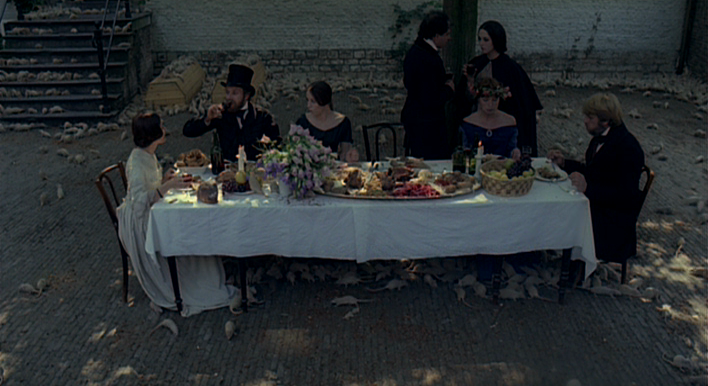
Herzog's contentious relationship with nature is a well-documented element of his persona: "Nature is a bunch of screaming bugs that want to strangle me in my sleep and poop in my sandwich. Also, it is drunk mosquitos." I might be getting that quote wrong. Anyhoo, Herzog understands Dracula's connection to the howling of wolves in the distance or to the clinging of a large bat to a lace curtain is the villain's most powerful, foreboding characteristic. When Dracula brings swarms of plague-bearing rats along with him to Harker's home city of Weismer, that's more horrifying, elemental and natural than any one-on-one blood-sucking could ever be.
Herzog envisions Dracula as the personification of disease-racked hopelessness, his pitiable infectiousness is the source of paranoia and despair in his victims - an anti-human plague of a creature. That Dracula is almost entirely indifferent to his victims, that his victims are plagued not by any intentional malice on his part but by rather as an unavoidance side-effect of his essential sickness, completes the Herzogian vision of nature as a sick, unthinking swarm, a torrent of misery and rot that cannot be otherwise. And, of course, as much as Herzog makes palpable the madness and sickness of the situation, he finds a beauty and joy in the scenes of the rats swarming over the mad, dancing crowds of Weismar who have decided to live their final moments to the fullest - he never neglects the "awe" in awfulness.
Herzog's world is one of rushing mountain rivers screaming away from Dracula's castle and fuzzy kittens playing in Lucy's kitchen. Maybe the most essential shot in the whole film is Isabelle Adjani as Lucy, her striking pallor as hauntingly gorgeous as for a corpse made up for the bier, awaiting Harker's return in a seaside cemetery, its graves jutting out at odd angles or tumbled over amidst the dunes. In this shot, Herzog precisely locates the beauty of the natural world, the inevitably of decay in nature, the overwhelming power of a grey sky set above a restless sea. The longing of woman broken in love, the loneliness of nature, the silence of God, the beauty of death, the sadness of life. Herzog's Dracula is the embodiment of the stillborn ache of eternity, the repulsive greed of nature to consume itself, to especially consume humanity. We can build graveyards and castles, but the grass will consume them. The dunes will consume them. The waves will consume them. And we will be left alone to rot and decay in our darkness like the Count in his coffin. Herzog's film will not make you feel horror; it will make you feel awful.
~ OCTOBER 24, 2013 ~
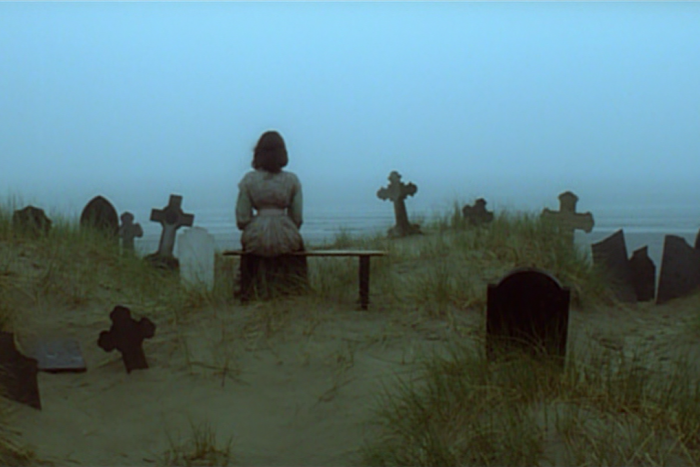
* i.e. Taking a hatchet to it, lopping it in a guillotine and/or emasculating it in a bathtub.






